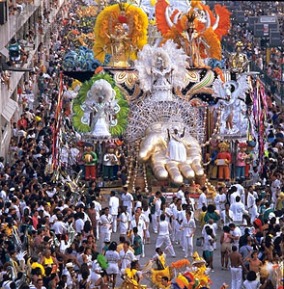Carnival in Rio
by Marcy Herr
Race and ethnicity: To describe the race and ethnicity of Brazil it is first important to understand the difference between these terms. Race is defined as each of the major divisions of humankind with distinguishing physical characteristics. Ethnicity is the fact or state of belonging to a social group that has a common national or cultural tradition. In Brazil, the ethnic group is composed of the following populations: 48.43% white, 43.80% mulatto (black and white mixed), 6.84% black and the remaining ~1% includes Japanese, Arab and Amerindian.
The diversity within the population in Brazil is due to the immigration that occurred to fulfill the need for workers in the coffee cultivation industry. Following the end of African slavery, immigration from other areas of the world increased. Italians, Portuguese, Spaniards, and Germans came from Europe, and later immigrants from other South American countries and Japan came to Brazil for work. It is said that there is no “typical Brazilian” because Brazil is such a melting pot of races from all around the world.
The following video demonstrates the variety of races and ethnicities that inhabit Brazil.
Brazil has a population of over 201 million ranking it 5th largest in population size worldwide. In the past 50 years Brazil has seen a decrease in fertility which has led to a slowing population growth rate, aging population and a shift in the demographics.
Religion: Brazil is a very religious country comprised of a variety of religions but predominantly Roman Catholic. 73.6% of the Brazilian population is Roman Catholic, 15.4% Protestant, 1.3% Spiritualist, other about 2% and no religion about 7%. As of 2007, Brazil had the second highest Christian population in the world.
The following link shows a short video example of what a typical Catholic church in Brazil looks like as well as parts of their religious ceremonies.
Urbanization: The urban population in Brazil makes up about 87% of the total population and the rate of urbanization is 1.1%. Over 20 million Brazilians immigrated from rural to urban areas in the period from 1950 to 1970 as cities really became developed and expanded. Urbanization slowed down around 1980 as Brazil was going through difficult economic times actually resulting in a emigration movement. The urbanization movement was so strong that the government had to create policies to limit growth in the large cities and encourage development to smaller ones instead. Currently 75% of people live on or near the coastline in cities, leaving much of the country uninhabited.
Language: The official language of Brazil is Portuguese which can be explained due to the influx of Portuguese speaking immigrants. Brazil is the largest Portuguese speaking country in the world and the only one in the Americas.
Culture: Rio Carnival is a great demonstration of the diverse culture of Brazil. Carnival highlights the beauty of ethnic traditions and brings them all together in a four day celebration ending on fat Tuesday, the day before ash Wednesday. This festival allows Brazilians to party and celebrate before sacrificing bodily pleasures for Lent. Carnivals are held all over Brazil, but the Carnival in Rio de Janeiro is the largest and most elaborate celebration. Carnival resembles a parade, and participants dress in costumes while singing and dancing. Each group of dancers is competing with their samba school and the judges observe a number of them throughout the four day event. Many of the participants from these samba schools live in the favelas, or slums of Brazil, and Carnival is something highly anticipated by them. Carnival really brings all sects of a community together to celebrate the culture and heritage of Brazil. Brazilians are expected to forget about social and class differences during the celebration. Originally brought to Brazil in 1850 from Portugal, this holiday has truly expanded to be a fabulous demonstration of many aspects of Brazilian culture.
Rio Carnival video:
It’s difficult to capture such a diverse culture in a short summary. The people of Brazil, although from so many countries around the world are united by their pride in their rich culture. Vibrant, friendly and generous are all used to describe Brasileiros who enjoy living a slow paced life. They take their time and try to enjoy the moment rather than rushing through life. Emphasis is put on relationships and family rather than inanimate objects. The culture of Brazil can be demonstrated in a variety of ways including art, music, theatre, literature, poetry and of course football. Culture is celebrated through Carnival, but Brasileiros enjoy dancing and partying with friends and family anytime.
Sources
http://whc.unesco.org/en/list/445
http://countrystudies.us/brazil/29.htm
https://www.cia.gov/library/publications/the-world-factbook/geos/br.html
